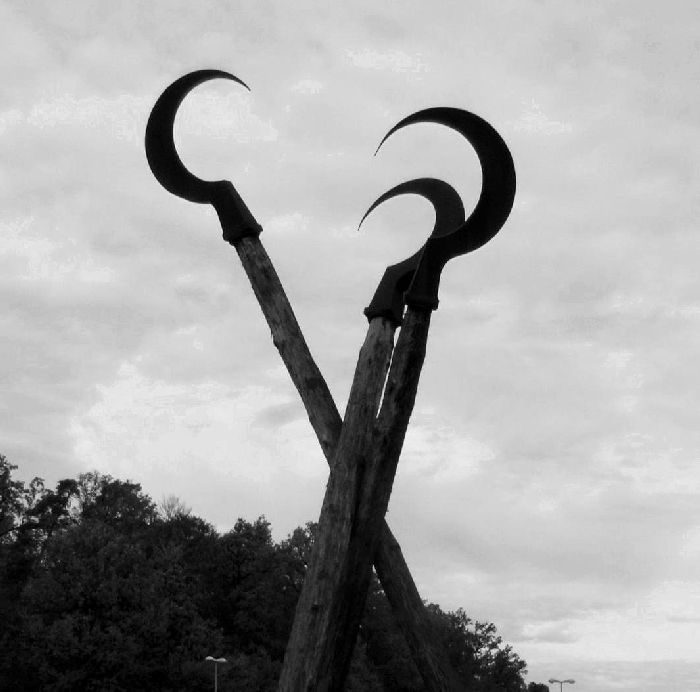Memorial to Deserters in Stuttgart
Pictures and text by Mark R. Hatlie
These pictures were taken on 30 August, 2007 in front of the Theaterhaus in Stuttgart, the evening the memorial was dedicated. The memorial home page can be found at www.deserteurdenkmal-stuttgart.de
See another deserters' memorial at sites-of-memory.de/main/ulmdeserters.html The blog entry for this memorial is at http://sitesofmemory.twoday.net/stories/4261731/

|
The MC for the event was Barbara Simons. She gave a brief recounting of the 11-year pre-history of the memorial. Both parts of the memorial were covered in cloth. This shows the larger, back portion. |

|
This is the smaller, front portion - and a view of the audience. The event was attended by several hundred people of all ages. |

|
Werner Schretzmeier is the head of the Theaterhaus and took the microphone to explain the motivation for letting the memorial be set up here until a more permanent location can be found in the down town area of Stuttgart. He put the idea in the context of the Theaterhaus tradition. It was founded in 1985 as a place for a counter-public-sphere, a place where things that are prohibited elsewhere are allowed. He remarked that Stuttgart sells itself as a liberal and open city and that therefor, this memorial belongs there. |

|
Military historian Prof. Dr. Messerschmidt gave an historical overview of the topic, pointing out other deserter memorial projects like that in Bonn. He recounted the debates that surrounded that memorial - all the political parties had opposed it. The city government had stated that the memorial would insult the soldiers who did serve in the Wehrmacht and were doing what they considered service to their fatherland. The federal government had even argued that "Deserters are people who avoid their responsibility to the community." Messerschmidt recalled the more than 15,000 men who were executed for desertion by the Nazi regime and the tenacious survival of the myth of the two wars: the dirty war being fought by the Nazis and SS and the "clean" war fought by the Wehrmacht. He also talked about the official status of desertion in German and international law and cited historical examples from various countries and contexts. |

|
One of the members of the audience was the sister of a man who had been executed for desertion during the Second World War. |

|
Johannes Opper from the group fojgl sang a Yiddish song. |

|
. |

|
. |

|
Then the memorial was unveiled. This is the best shot I could get. The others were ruined by heads and hands holding cameras. |

|
. |
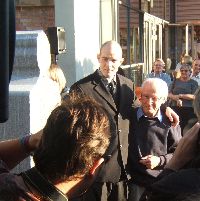
|
The men who did the actual unveiling were Chris Capps (left) and Ludwig Baumann. |
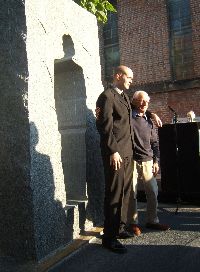
|
They posed in front of the memorial and gave all us greedy photographers a chance. |

|
. |
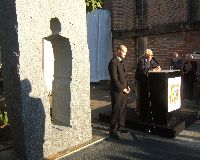
|
Then Baumann spoke. He deserted the Wehrmacht with a buddy in 1942. He was sentenced to death, but ended up serving 10 months in prison and then being sent into battle in a punishment batallion where most of the men were killed, including the man he deserted with. He returned home after the war only to be further villified by society, called a Dreckschwein ("dirty pig") and a coward. Only in the 1980s did he start to get recognition - from the peace movement. He recounted some of the postwar legal history for Wehrmacht deserters, how their legal rehabilitation was resisted because it would supposedly criminalize those who did serve or because it was feared it would undermine the moral of the Bundeswehr. He asked rhetorically, What could be better than betraying a war? |

|
. |

|
Chris Capps is a deserter from the "Global War on Terror." He refused to deploy to Afghanistan with his unit, went AWOL, turned himself in, and was released from the service. He compared his easy way out - he had risked a few months in jail at most - with the deadly danger faced by Ludwig Baumann for his desertion. He got what seemed like greater applause than Herr Baumann, however! |

|
The last speaker was Prof. Dr. Renate Gebessler who introduced the memorial as
artwork, comparing it to the proposed memorial originally chosen by
the jury, a memorial sunken into the ground. She said that other design would have
spoken to the dead of the past more than speaking to the future like this memorial.
She pointed out that this memorial is only slightly larger than life - hardly "monumental"
at all. She offered several possible interpretations of the memorial, for example
the idea that the hole in larger piece represents not only the hole in the
line left by the deserter, but also a window through which his (former) comrades
in arms can view another possible course of action. The human figure part of the memorial
is a human standing alone, taking responsibility for his actions.
|

|
. |

|
. |

|
. |

|
. |
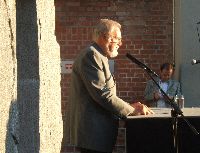
|
Heinz Wienand read a poem. |

|
. |
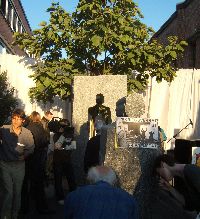
|
. |

|
. |

|
. |
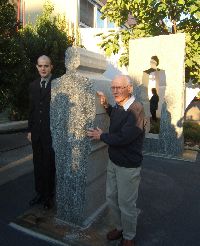
|
. |

|
Opper played in the background after the ceremony while visitors inspected the memorial close up. |

|
. |
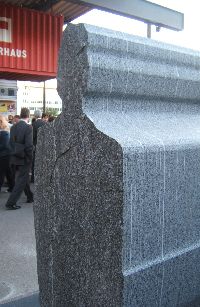
|
. |
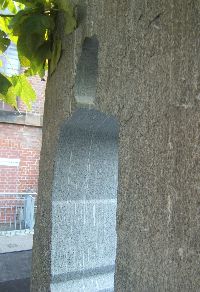
|
. |

|
The plaque at the foot of the memorial reads, "Dedicated to the deserters of all wars / Sculptor Nikolaus Kernbach, profile cut 1996/2001, stonemakers Treulieb Stuttgart / The Initiative for a Desserters Memorial in Stuttgart, 2007." (Gewidmet den Deserteuren aller Kriege / Bildhauer Nikolaus Kernbach, Aulendorff, Profilschnitt 1996/2001, Ausführung Steinmanufaktur Treulieb Stuttgart / Initiative Deserteurdenkmal für Stuttgart, 2007.) |

The visit to this location was paid for by a research grant from the American Public University System. "Educating those who serve." |
